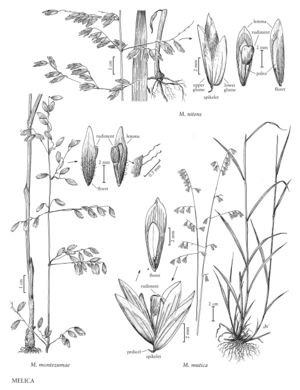Melica mutica
Plants not or loosely cespitose, shortly rhizomatous. Culms 45-100 cm, not forming corms; internodes sometimes scabridulous above the nodes. Sheaths glabrous or pilose; ligules 0.5-1.5 mm; blades 1.8-6 mm wide, abaxial surfaces glabrous, scabridulous, adaxial surfaces with hairs. Panicles 4-25 cm; branches 3.5-6 cm, appressed to spreading, straight, with 2-5 spikelets; pedicels sharply bent below the spikelets; disarticulation below the glumes. Spikelets 6-11 mm, with (1)2(4) bisexual florets, floret apices at about the same level; rachilla internodes 1.5-1.7 mm. Lower glumes 4.5-8 mm long, 3-4 mm wide, 5-7-veined; upper glumes 5-9 mm long, 2.5-3.5 mm wide, 5-6-veined; lemmas 6-11 mm, glabrous or scabrous, indurate, 9-11-veined, veins prominent, apices rounded to acute, unawned; paleas about 3/4 the length of the lemmas; anthers 1-3 mm; rudiments 2-3 mm, clublike, not resembling the bisexual florets, at a sharp angle to the rachilla. 2n = 18.
Distribution
Md., N.J., Okla., Miss., Tex., La., W.Va., Ala., D.C., Tenn., N.C., S.C., Va., Ark., Ill., Ga., Ind., Iowa, Ky., Fla.
Discussion
Melica mutica grows in moist or dry areas in open woods and thickets, from Iowa and Texas east to Maryland and Florida. It is unique among the North American species in having a clublike rudiment at a sharp angle to the rachilla.
Selected References
None.
